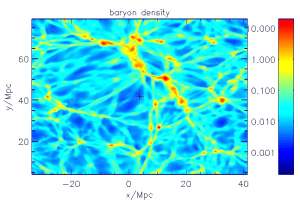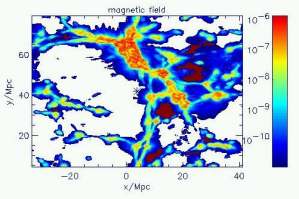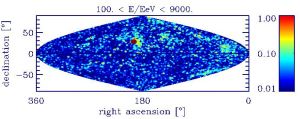| MPA HOMEPAGE |
|
||||||||||||||||||
 |
|
||||||||
| Current Research Highlight :: January 2004 | all highlights |
Protons with Horsepowers: |
||||||||||||||
|
Ultrahigh-energy particles are the most energetic particles known to exist in the Universe. Each of them owns an energy of up to 10 to 21 electron-Volts. This is nearly the energy of a horse's kick, concentrated in a single proton. Particles with such an enormous energy cannot be confined even within the vast extent of our own Milky Way galaxy leading to the conclusion that they must have an extragalactic origin. Whenever an ultrahigh-energy particle hits the Earth's atmosphere, the atmosphere's atoms burst in such collisions. The debris of the collision penetrates deeper into the atmosphere and causes a fluorescencing flash of light. During the last decades less than a hundred of such events were recorded with specialised telescopes which, by looking at the light flashes they produce, reconstruct the particles energy and arrival direction. However, the light flashes do not provide information about the particles' journey to Earth. In fact, the particle arrival direction does not necessarily say where the particle is coming from, because the particle direction of motion is deflected by the presence of extended extragalactic magnetic fields. Strength, orientation, and length-scale of the magnetic fields outside our Milky Way are unknown. It is also unknown from where the particles originate: radio galaxies, giant black holes, mysterious gamma-ray bursts, or from completely unknown processes? Günter Sigl, Francesco Miniati and Torsten Enßlin simulated possible extragalactic journeys of these protons and tried to infer which ones are more likely by making a statistical comparison of the result of different scenarios with observational data. More specifically, they investigated whether the particles originate in a small number of powerful sources (i.e. each producing many particles) or, conversely, in a large number of weak sources; whether the sources are distributed as cosmic matter in the neighbourhood of the Milky Way or are homogeneous in space; what kind of magnetic fields (strong or weak) and thereby of deflections of the particle trajectories should be expected. The conclusion is that in a statistical sense the observational data favour a scenario in which the sources of ultrahigh-energy particle are neither few and strong nor numerous and weak, but moderate both in number density and power of particle production. They are placed with an average separation of 100 million lightyears from each other, but their distribution is not homogeneous. They are roughly distributed as the galaxies in the neighbourhood of the Milky Way. According to the best-fit scenario, the magnetic fields are strong in the vicinity of their sources, and weak but non-negligible within the huge space in between the sources and the Milky Way. Therefore, most of the particles should have been deflected by several ten degrees. However, a significant fraction should have taken a relatively direct route and the directions of the atmospheric lightflashes should in those cases be roughly the initial directions of the particles and point back to their sources. Thus, as soon a sufficient high number of detections will be reached, an excess of events in the direction of the most important sources should be observable. This scenario implies that many of the ultrahigh-energy particles may originate in the galaxies of the nearby Virgo galaxy cluster. However, due to the presence of strong magnetic fields within the Virgo cluster it should be difficult to identify their source locations exactly within the cluster.
In conclusion, the results of the simulation favour
conservative theories about the origin of the particles, which
suggest a connection between the galaxy distribution and the
source locations. They also fit well to our ideas about
extragalactic magnetic fields. Future observations with telescopes
(e.g. the Torsten Enßlin, Francesco Miniati, Günter Sigl
|
| © 2003—2022, Max-Planck-Gesellschaft, München |
last modified: 2004-1-8
|
|



